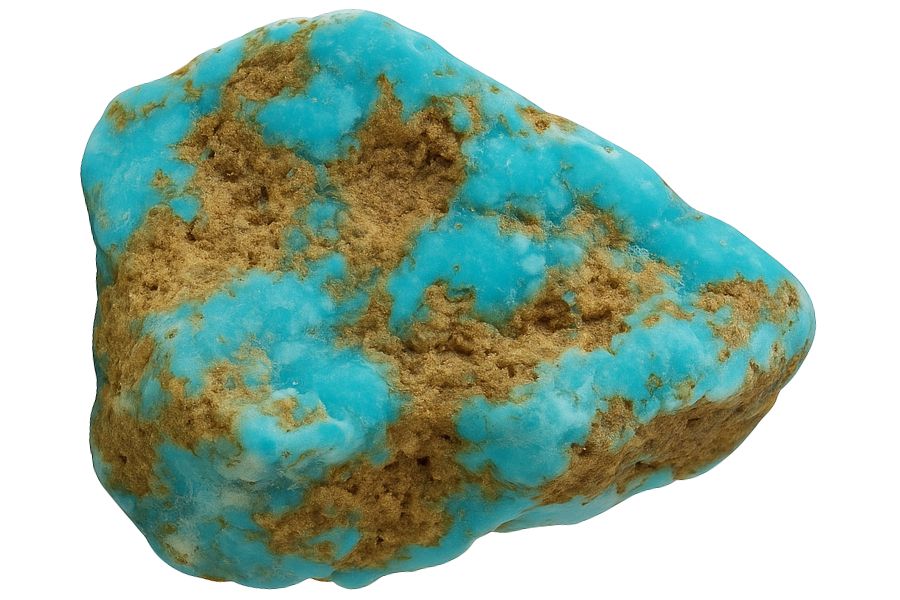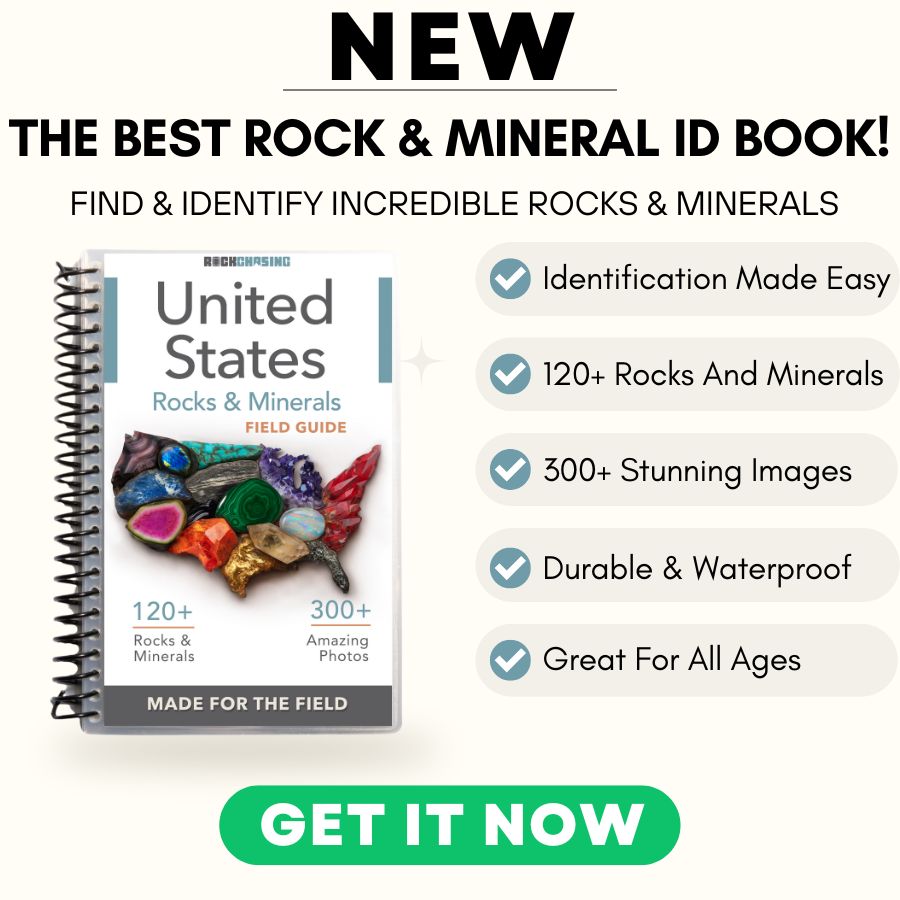Arizona is a premier destination for anyone seeking to a bit of gem hunting. Its expansive desert landscape and rugged mountains hold a wide variety of minerals waiting to be discovered.
Different kinds of terrain across Arizona can hold gems in surprising places. Riverbeds, dry washes, and gravel bars can all carry stones that have been moved from their original locations. Old mining areas also provide promising ground for those willing to search through the piles.
We’ll point you toward the best places where you can try your luck at finding gems in Arizona. Knowing which spots have the most promise and what details to pay attention to can make the difference between leaving empty-handed and going home with a collection of beautiful stones.
- The extensive local experience and understanding of our team
- Input from several gem hunting groups and organizations
- The accessibility of the mining locations
- Safety and potential hazards when collecting
- Private and public locations
- A desire to include locations for both experienced gem hunters and those who are just starting out
Overall, we’ve been able to put together a great list that anyone can use to locate a lot of beautiful gems.
The Gemstones Found In Arizona You Can Mine
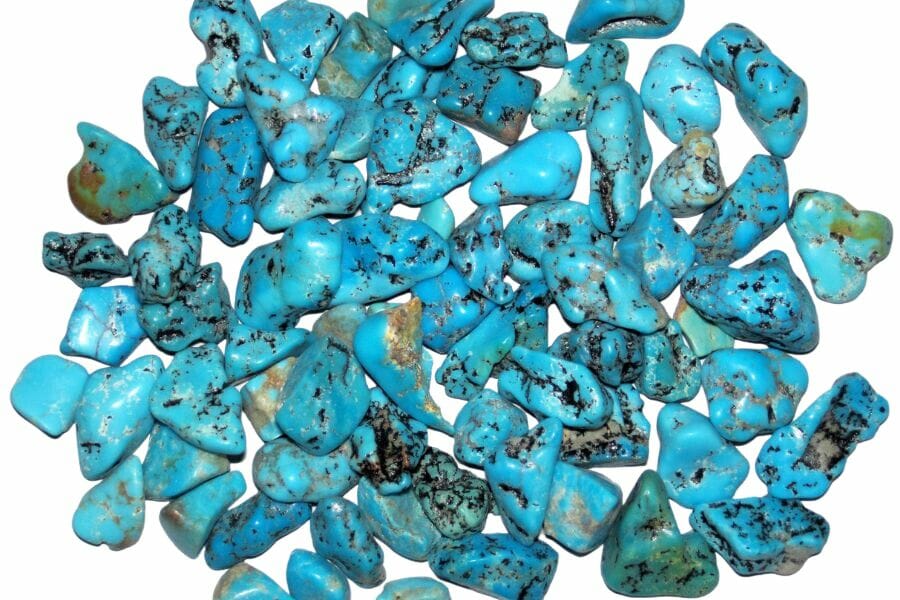
Our state possesses such diverse varieties of gemstones and gem hunters who get to visit here are lucky to have the chance to do so. We’ve also created guides to help you discover gem mines near you, no matter where you are planning to do gem hunting in. You will see just how rewarding this activity can be if you have the right knowledge and just a bit of luck!
Onyx
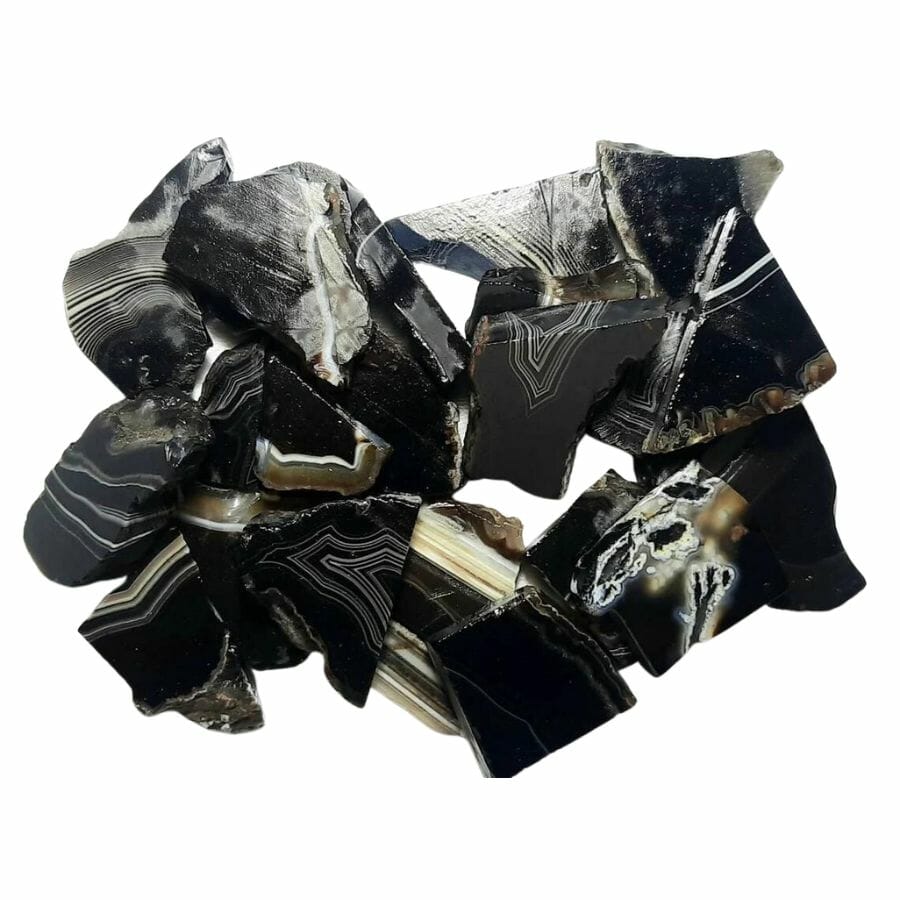
Onyx is a kind of chalcedony, which is a fancy word for a type of quartz. What’s special about onyx is its bands of colors, often black and white, lined up in perfect harmony. Imagine zebra stripes, but in a stone!
It’s one of the most popular gemstones found in Arizona for good reason!
Now, let’s get to the cool part of how onyx comes to life. It starts with water dripping down into tiny nooks and crannies in the ground.
This water is filled with minerals. Over time, as the water evaporates, these minerals are left behind and they start stacking up, layer by layer.
And after many, many years, voila, we get the beautifully banded onyx. Arizona, with its rich history and geology, has different pockets where onyx can be found.
Onyx’s elegant bands make it a favorite for jewelry and decorations. It’s been used to make a wide variety of things, from earrings to chess boards! Plus, in history, some folks believed onyx could protect them from harm.
Where you can find onyx in Arizona
- Yavapai Onyx Mining Corp. quarries, Big Bug Creek, Mayer
- Stone World Rock Quarry, Big Bug Creek, Mayer
Shattuckite
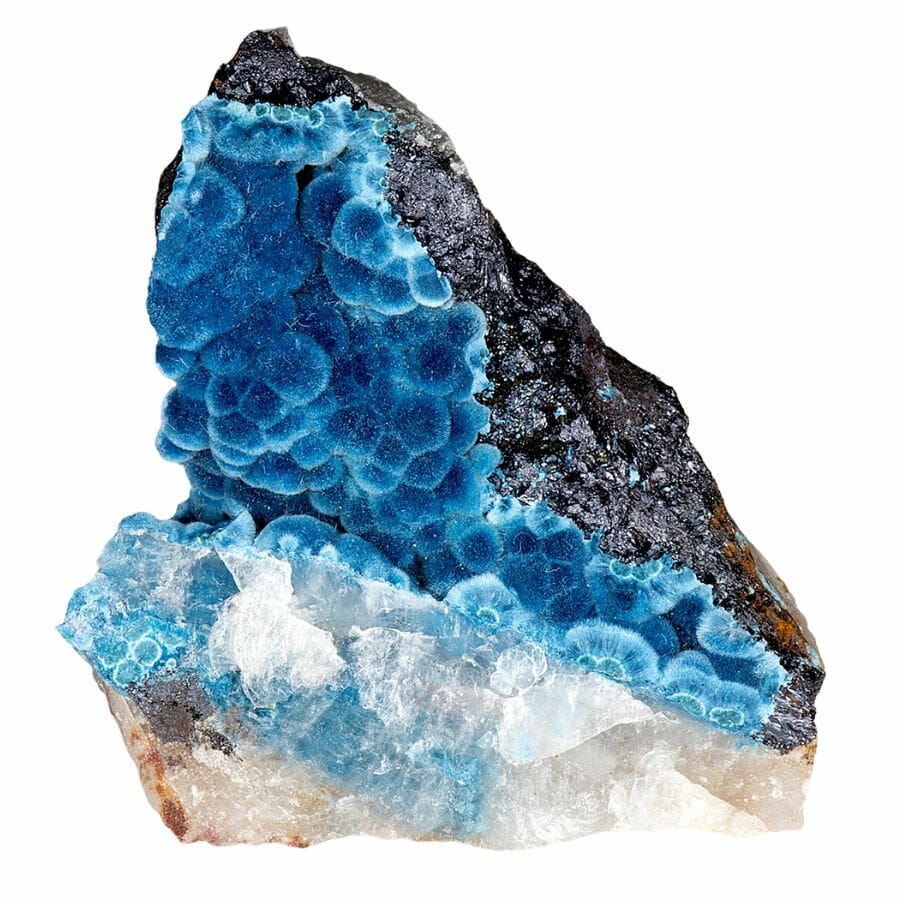
Shattuckite belongs to the copper silicate family. Now, if you’re wondering what that means, just think of it as a mix between the green of copper and the sandy touch of silica. Combine them, and you get this blue wonder!
In places where copper ores are found, there’s often a lot of water moving around underground. This water reacts with the copper, and together, they start forming new minerals.
As the mixture of copper and silica settles into spaces and cracks over time, shattuckite is born.
Arizona’s mineral-rich grounds provide the perfect setting for shattuckite to come to life. You can find it in various forms, from delicate coatings on rocks to stunning crystalline formations.
Shattuckite’s striking blue hue is simply mesmerizing. It’s no wonder why jewelers and rock collectors love it!
But it’s not just about the looks. Some believe that shattuckite has the power to enhance communication and intuition.
Where you can find shattuckite in Arizona
- Nugget Fraction Mine (Nugget Fracture property), Silver Reef Mountains, Tat Momoli Mountains, Silver Reef Mining District
- New Cornelia Mine, Ajo, Little Ajo Mountains, Ajo Mining District
- Eagle Eye Mine, Moore Mine group, New Water Mining District, New Water Mountains
- Shattuck Mine, Bisbee
Amethyst
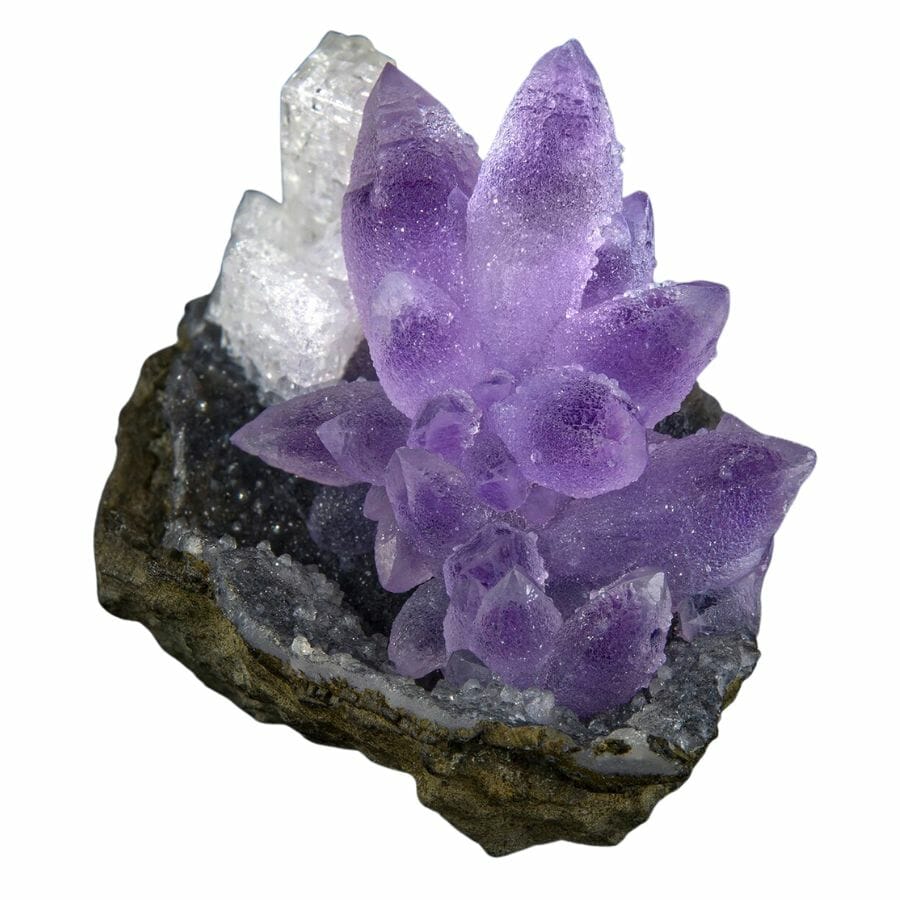
Imagine a stone that looks like the color of grape juice – that’s amethyst. It’s a type of quartz, which is a super common mineral, but what makes amethyst special is its pretty purple color.
Amethyst forms deep beneath the Earth’s surface. When hot molten rock called magma starts to cool down, it can form little pockets. Inside these pockets, there’s super hot water filled with all sorts of minerals.
Over time, as this water cools down and starts to move away, the minerals in the water begin to crystallize.
If the right mix of minerals is present, like iron, and if it gets exposed to the right amount of radiation from the rocks around it, we get the gorgeous purple amethyst.
Arizona is a special place for amethyst because the conditions there are just right. The state has plenty of volcanic activity in its past, which created a lot of those underground pockets where amethyst could form.
Many believe that amethyst has healing properties. It’s also been used in jewelry for thousands of years. Whether you believe in its powers or just love the way it looks, there’s no denying that amethyst is a rock star in the world of minerals!
Where you can find amethyst in Arizona
- Maricopa Mining Corp. Mine, Four Peaks
- Date Creek, Congress Junction area, Martinez Mining District, Date Creek Mountains
- Cameron, Cameron Mining District
You can check out this guide to discover more spots where you can find amethyst:
Peridot
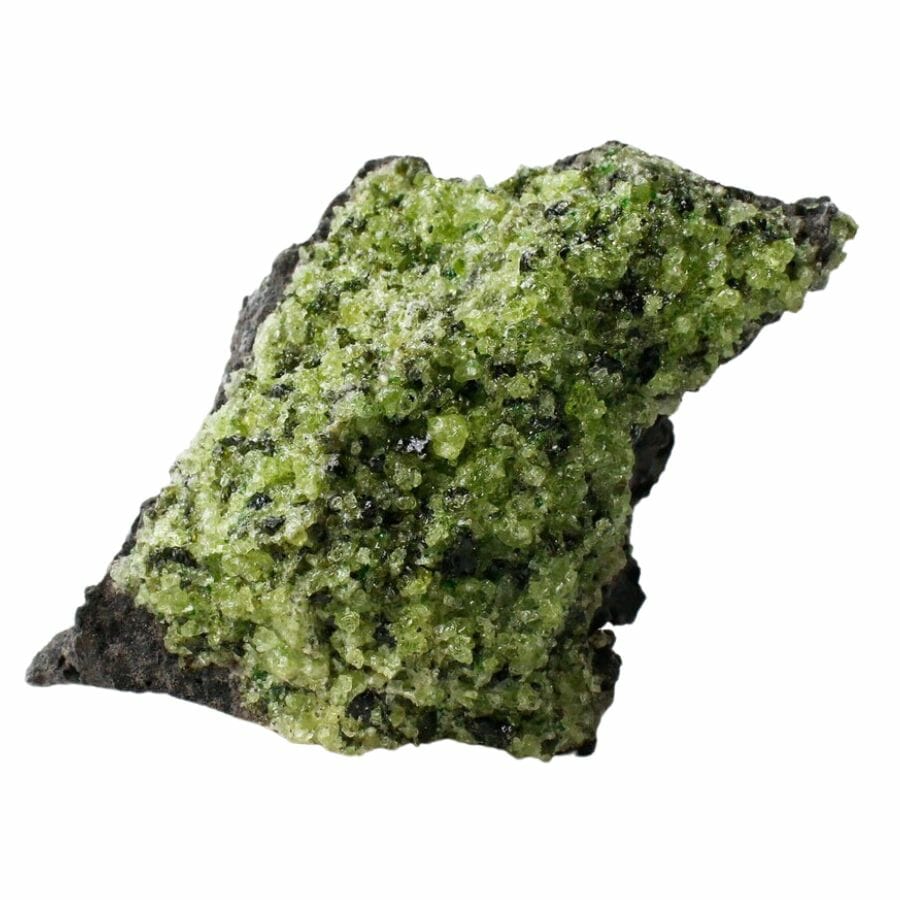
Among the many rocks and minerals found in Arizona, peridot stands out with its vibrant green sparkle. It’s a zesty, brightly colored gem that dazzles in the sunlight.
What’s cool is that peridot is one of the few gems that only comes in one color. But it can range from a yellowish-green to a deeper olive shade.
Now, let’s get to the magical part: how it forms, especially in a place like Arizona. Deep down in the Earth, way below our feet, there’s a lot of heat and pressure. Under these extreme conditions, peridot crystals begin to grow in the molten rock.
Sometimes, this molten rock with peridot in it shoots up to the surface in violent volcanic eruptions. As the lava cools and hardens, voilà! We have rocks with peridot crystals inside them.
Arizona has a history of these volcanic activities, which is why it’s a hotspot for peridot.
Historically, peridot was cherished by ancient Egyptians and believed to keep away evil spirits. In modern times, many love it for its bright color, and it’s even the birthstone for August babies!
Where you can find peridot in Arizona
- San Carlos Apache Indian Reservation
- Peridot Mesa (Peridot occurrence 38), San Carlos
- Peridot Canyon, San Carlos
Obsidian
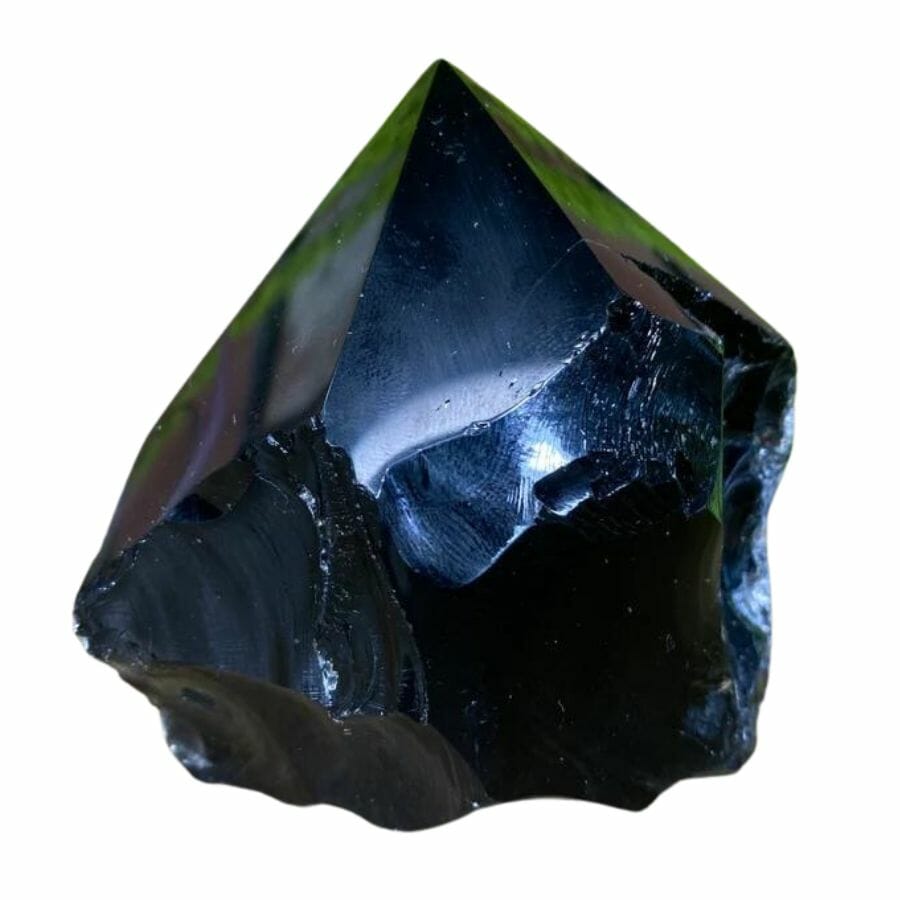
The diverse range of gemstones found in Arizona makes the state a paradise for rock enthusiasts and collectors. Obsidian is one of the best examples of the gems you can find in this state.
Obsidian is like glass, but it’s usually a deep black, sometimes with streaks of other colors. It has this glassy look because it’s actually volcanic glass!
Here’s the lowdown on how obsidian forms, especially in cool places like Arizona. When volcanoes erupt, they spew out a hot, gooey material called lava.
Now, if this lava cools down super quickly, it doesn’t have time to form regular crystals like other rocks.
Instead, it hardens swiftly and turns into this shiny, smooth obsidian.
Because of Arizona’s history of volcanic activity, you can find obsidian in various parts of the state. With the right conditions, Arizona’s volcanoes provided the perfect obsidian-making recipe!
Ancient folks made tools and weapons out of obsidian because it can be chipped into super sharp edges. Nowadays, it’s popular for making jewelry and artwork.
Plus, some people believe obsidian has protective qualities, like a shield against bad vibes.
Where you can find obsidian in Arizona
- Chiricahua Mountains, Cochise County
- Superior, Pioneer Mining District, Pinal Mountains
- Superior Obsidian locality, Superior, Pioneer Mining District, Pinal Mountains
Arizona has a lot of other areas where you can find obsidian. See our guide below:
Turquoise

Turquoise is a rock with shades of blue and green, often mixed with cool patterns. It looks as cool as a summer pool!
Turquoise forms in areas with dry climates, like deserts and places where it’s often sunny. When rainwater, which has some specific minerals dissolved in it, seeps into the ground, it can react with certain rocks.
With enough time, all these ingredients create turquoise.
The bright, unmistakable colors of turquoise make it a favorite for jewelry. Imagine wearing a piece of the Arizona sky around your neck!
Native American cultures have also cherished turquoise for centuries, using it in beautiful artwork, jewelry, and even for spiritual ceremonies. People believe it has healing powers and can bring good luck.
Arizona turquoise is known to be some of the best in the world! That’s why it can fetch a hefty price tag.
Where you can find turquoise in Arizona
- Canyon Creek turquoise deposit, Canyon Creek, Fort Apache Indian Reservation
- West Side Mine, Tombstone Mining District
- Morenci Mine, Morenci, Greenlee County
Fire Agate

Fire agate is a gem that’s as fiery and exciting as its name suggests. It’s a stone that glows with a rainbow of warm colors, just like flames dancing in a fireplace.
Fire agate forms in volcanic areas, where hot molten rock once flowed. Over time, layers of silica and water build up in the cracks and bubbles of the old lava.
These layers stack up like pancakes and, with the magic touch of heat and pressure, turn into the glowing fire agate.Guess what state has lots of this volcanic history? You got it – Arizona!
You’d be surprised at how many valuable rocks in Arizona are just waiting to be discovered by keen explorers!
Fire agate has showy colors that make it a superstar for jewelry. It’s like wearing a bright flame! People also value it for its unique play of colors, where the stone seems to shimmer and change as you move it.
Plus, some believe fire agate has the power to energize and guard its wearer.
Where you can find fire agate in Arizona
- Deer Creek Fire Agate Mine, Graham County
- Black Hills Rockhound Area, Black Hills
- Saddle Mountain, Maricopa County
Petrified wood
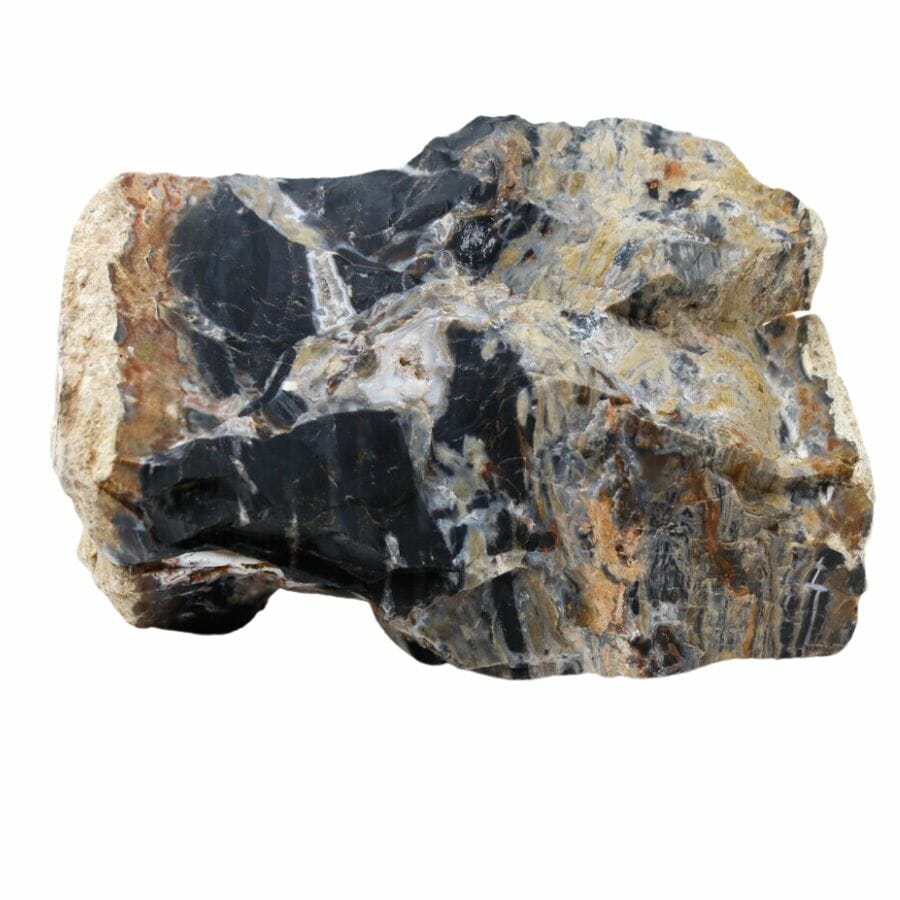
Imagine a tree that turned into stone. Sounds crazy, but it’s true! Petrified wood is wood that has been turned into rock.
When trees die and get buried under layers of mud, ash, or other stuff, they get protected from the usual rotting process. Instead of rotting away, the wood’s cells slowly get replaced by minerals like silica.
Over a very long time, these minerals turn the wood to stone, while still keeping the tree’s shape and even its rings!
Arizona, with its unique combo of ancient forests, volcanic ash, and groundwater, became one of the best places for creating petrified wood.
Having a piece of petrified wood in your hand is like holding a piece of ancient history. This is why it’s one of the most valuable rocks in Arizona.
In places like Arizona’s Petrified Forest National Park, you can even see giant logs of petrified wood that are millions of years old.
People also use slices of petrified wood in jewelry and decorations because it’s just so beautiful. Petrified wood can show off amazing colors, from deep reds and purples to shimmering blues and greens.
Where you can find petrified wood in Arizona
- Unnamed Petrified Wood localities, Springerville, Apache County
- Holbrook, Navajo County
- Black Mesa Coal Mine, Black Mesa
Arizona has a wealth of petrified wood! You can find more spots to explore in this guide:
Black Jade
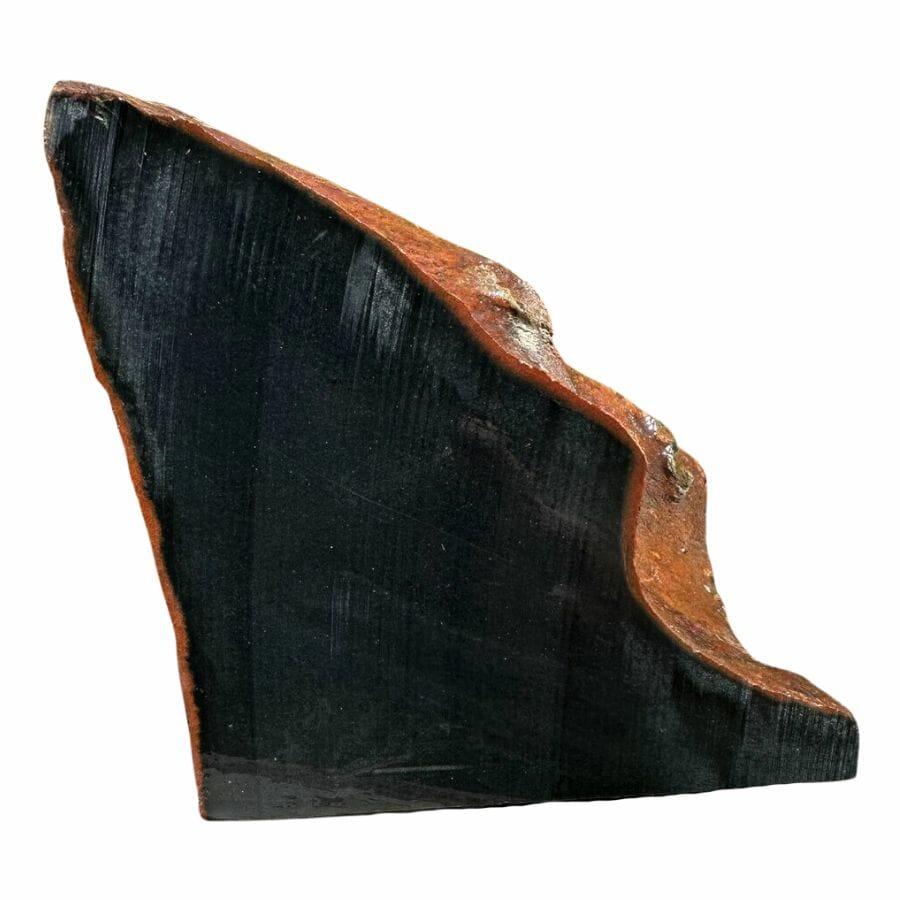
Think of a stone as dark as the night sky, but as shiny as a star. That’s black jade, and it’s a real gem!
Jade isn’t just one mineral, but two: nephrite and jadeite. These minerals form deep in the Earth when certain rocks melt and mix together. This melting pot of minerals gets pressed and squeezed under loads of pressure until jade is formed.
Black jade develops because of the presence of graphite or iron. Arizona is one of the places in the world that’s known to produce black jade.
This stone has a deep, dark color that’s mesmerizing and looks super sleek in jewelry. Black jade has been used for centuries by many cultures for carvings, statues, and amulets.
People believe that it has protective qualities, keeping bad vibes away. Plus, because it’s tougher than steel, it’s super durable and can last a really long time.
Where you can find black jade in Arizona
- Bradshaw Mountains
Agate
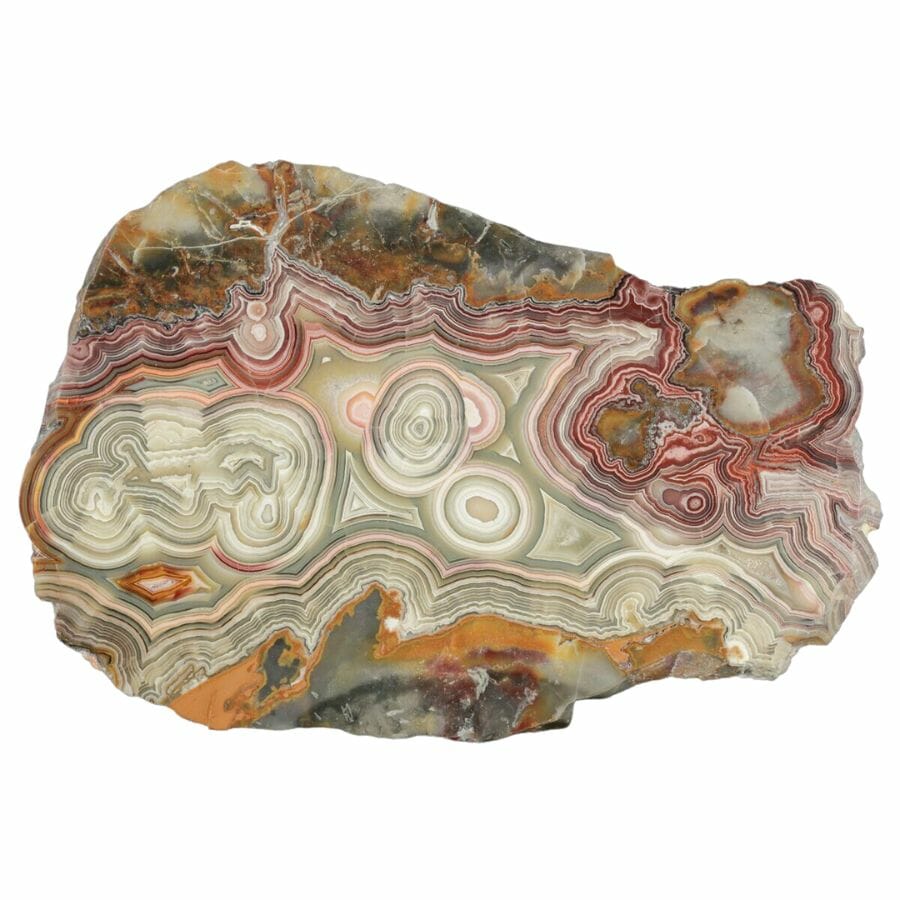
Agate is a type of quartz and is often colorful, with bands, swirls, and patterns that can be mesmerizing! You might see oranges, blues, greens, reds, and other fun shades dancing around inside.
This mineral starts off in ancient volcanic rock. Over a long time, water with silica (that’s stuff found in sand) drips into cracks and empty spaces in the rock. Layer by layer, the silica hardens and turns into agate.
It’s a bit like how a pearl forms inside an oyster, but this happens deep in the ground!
Arizona is an awesome spot for agate. The desert here has just the right conditions for creating this rock superstar.
Folks value agate because its colors and designs are just gorgeous! Jewelers use agate to make beautiful jewelry, like necklaces and earrings. Plus, some people believe that agate has healing powers or can bring good luck.
But even if you’re not into that, just looking at the amazing patterns can be super relaxing and cool.
Where you can find agate in Arizona
- Warbonnet Ranch, Cochise County
- Bull Canyon, Boriana Mining District, Hualapai Mountains
- Arizona Agate deposit, Yavapai County
Arizona has a lot of other places where you can find agate. You can check them out in this guide:
Azurite

Azurite is one of the most eye-catching rocks and minerals found in Arizona. It’s this cool, bright blue stone that looks like it’s borrowed its color straight from a summer sky.
Azurite is made up of copper, carbon, and oxygen. When you think of copper, you might picture shiny pennies. But in nature, copper can combine with other elements and make beautiful minerals like azurite.
The process usually starts in places where there’s copper-rich rock. When water and air get to this rock, they help create azurite. It often appears in cracks, crevices, and spaces where the water can flow and leave behind the vibrant blue mineral.
And sometimes, you might find it hanging out with its green buddy, malachite. Together, they create a stunning duo!
Azurite’s brilliant blue has caught people’s eyes for ages. In the old days, artists ground it up to make a vivid blue paint. Today, collectors and jewelers still love it for its striking color.
Where you can find azurite in Arizona
- Rosalie Mine, Brooklyn Peak
- Yuma Mine, Ellsworth Mining District
- Mammoth-Saint Anthony Mine, St. Anthony deposit, Tiger, Mammoth Mining District
Calcite

Calcite is like the chameleon of the rock world because it can be found in a rainbow of colors, from clear to yellow, pink, and even green! Its looks can vary, but it’s always made of calcium, carbon, and oxygen.
Here’s the cool part about how calcite is made: It often forms from the remains of ancient sea critters.
Over time, shells and bits of coral pile up on the ocean floor. Pressure from the layers above squeezes them all together and, voila, we get calcite!
But that’s not the only way. Calcite can also form in caves as water drips down, leaving behind minerals that build up as stalactites and stalagmites.
This mineral is not only pretty to look at but is also super useful. It’s been used in construction and to make cement.
Arizona, with its rich geology, has been a cool spot for finding calcite. From cave formations to ancient sea beds, this state is a treasure trove for mineral enthusiasts.
Where you can find calcite in Arizona
- Henrietta Mine, Big Bug Mining District, Bradshaw Mountains
- Cypress Mine, Bagdad, Eureka Mining District
- Big Sandy Valley, Mohave County
Carnelian
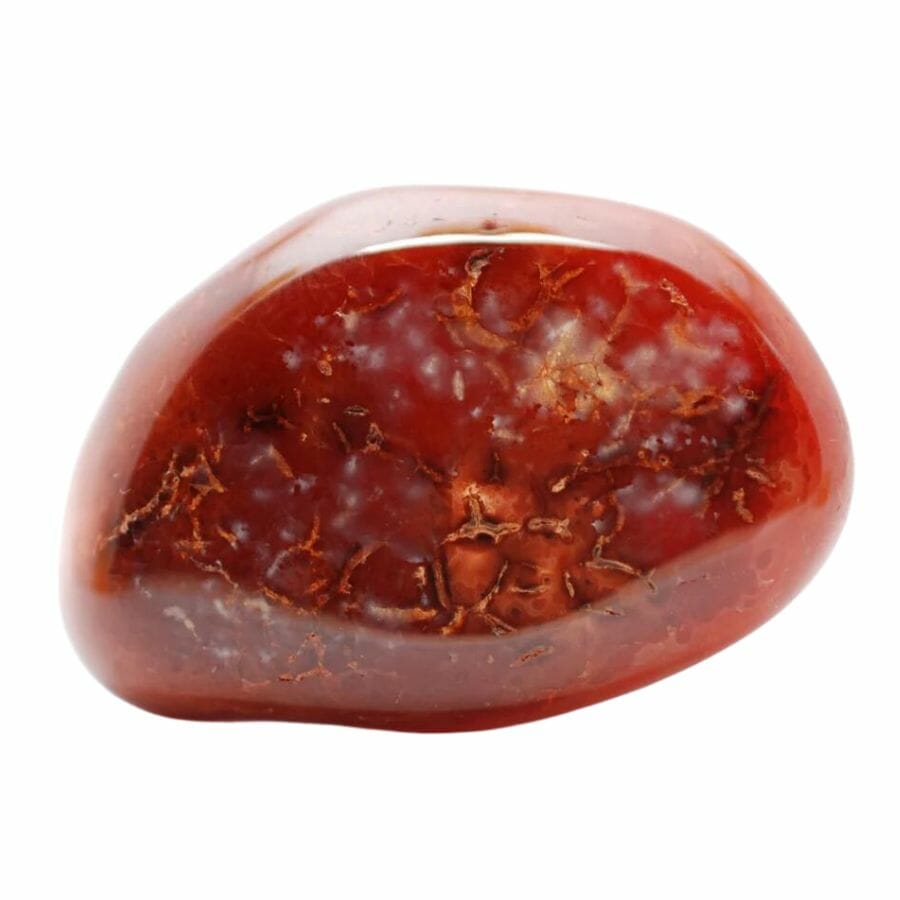
Carnelian is a member of the quartz family, just like its cousin agate. What makes carnelian special is its fiery range of colors. From pale orange to deep reddish-brown, it’s a stone that captures the warmth of the sun!
Now, the magic behind its formation: carnelian gets its colors from iron. Over a really long time, water carrying tiny bits of iron flows into gaps in rocks.
As the water evaporates, the iron mixes with quartz and gives us the lovely shades of carnelian. It’s a slow dance of nature, taking thousands of years to complete.
Arizona, with its deserts and unique geology, is a great place for finding gems like carnelian.
People base the worth of carnelian on its beauty and toughness. Picture the warm, glowing colors of a desert sunset, and you’re imagining the hues of carnelian. Its vibrant colors are perfect for making jewelry.
Wear a piece of carnelian, and you’re wearing a slice of Arizona’s fiery sunsets!
In history, some also believed carnelian brought courage and good luck.
Where you can find carnelian in Arizona
- Pantano – North of, Empire Mining District, Empire Mountains
- Saddle Mountain, Maricopa County
- Joseph City, Navajo County
Chalcedony

Chalcedony is a type of quartz, and it has this cool, waxy luster. It can show up in many colors, but often it’s found in dreamy blues, milky whites, and sometimes even a mix of colors.
Let’s break down the magic of how it’s made: imagine water flowing through tiny cracks and holes in the ground, carrying with it little bits of silica. As the water dries up, the silica left behind starts to form crystals.
Over a long, long time, these tiny crystals band together and become chalcedony.
Besides being easy on the eyes, people have loved and used this stone for ages. Jewelers adore it for its smooth, glowy look, perfect for creating dazzling jewelry pieces.
And let’s not forget, some folks believe chalcedony can balance emotions and bring a sense of peace.
Arizona offers a perfect home for chalcedony. The state’s rich geology paints a canvas of colors and stories in the form of minerals. Chalcedony is one such tale of time and beauty.
Where you can find chalcedony in Arizona
- Anna Bernice claims, Joseph City
- Mac No. 3 prospect (Mac #3), Sun Valley, Petrified Forest Mining District
- Agua Fria River (stream), Bradshaw Mountains
Chrysocolla
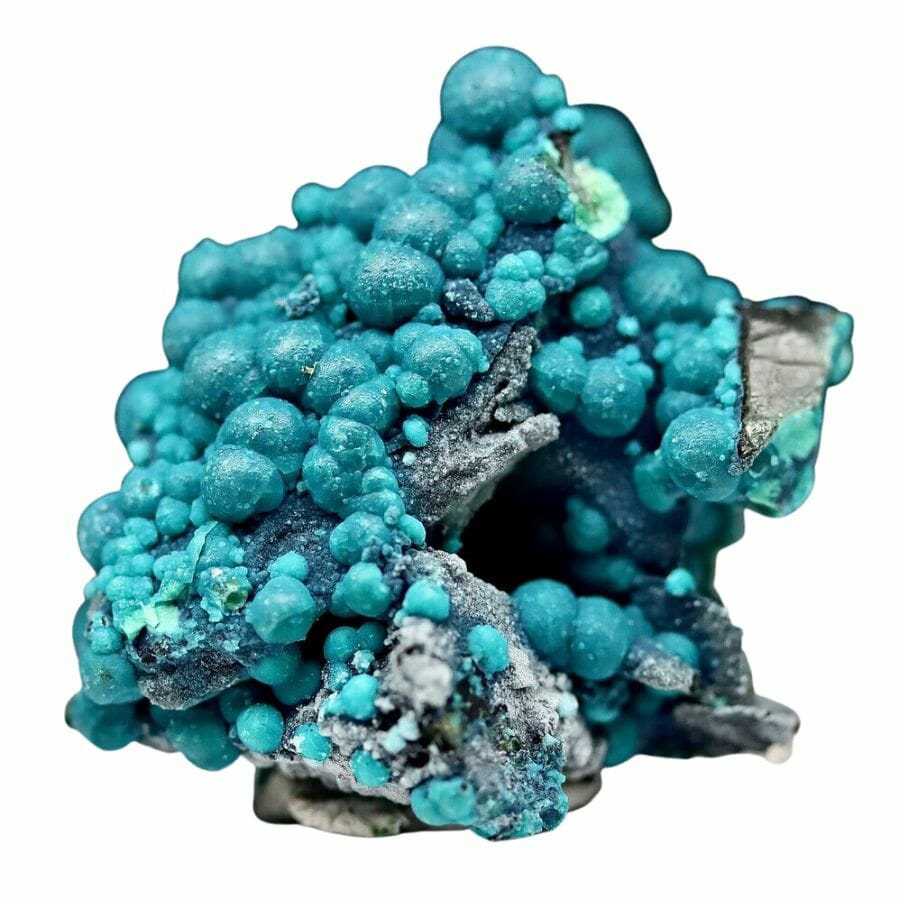
Chrysocolla is known for its eye-catching blue and green colors, kind of like a mix between the sky and a cactus! It’s closely linked with copper, which is a big deal in Arizona. This copper connection is the secret behind chrysocolla’s cool colors.
When rainwater meets copper-rich rocks, it helps break down the copper. As the water moves, it carries the copper along with it. Over time, the copper combines with other stuff like silica, and together, they form chrysocolla.
The resulting colors are absolutely enchanting. That’s why chrysocolla has been used to make jewelry that can make anyone stand out in a crowd.
On top of that, some people believe chrysocolla has calming vibes and can help with communication. It’s like having a pocket-sized peace buddy!
Arizona’s vast landscapes and deep copper mines make it a prime spot for chrysocolla. This mineral is a shining example of how the desert hides colorful secrets in its depths.
Where you can find chrysocolla in Arizona
- 79 Mine, Chilito, Hayden area, Banner Mining District
- Buckeye Copper Mine, Spring Mountain, Webb Mining District, Gila Bend Mountains
- Copperstone Mine, La Paz Mining District, Dome Rock Mountains
Fluorite
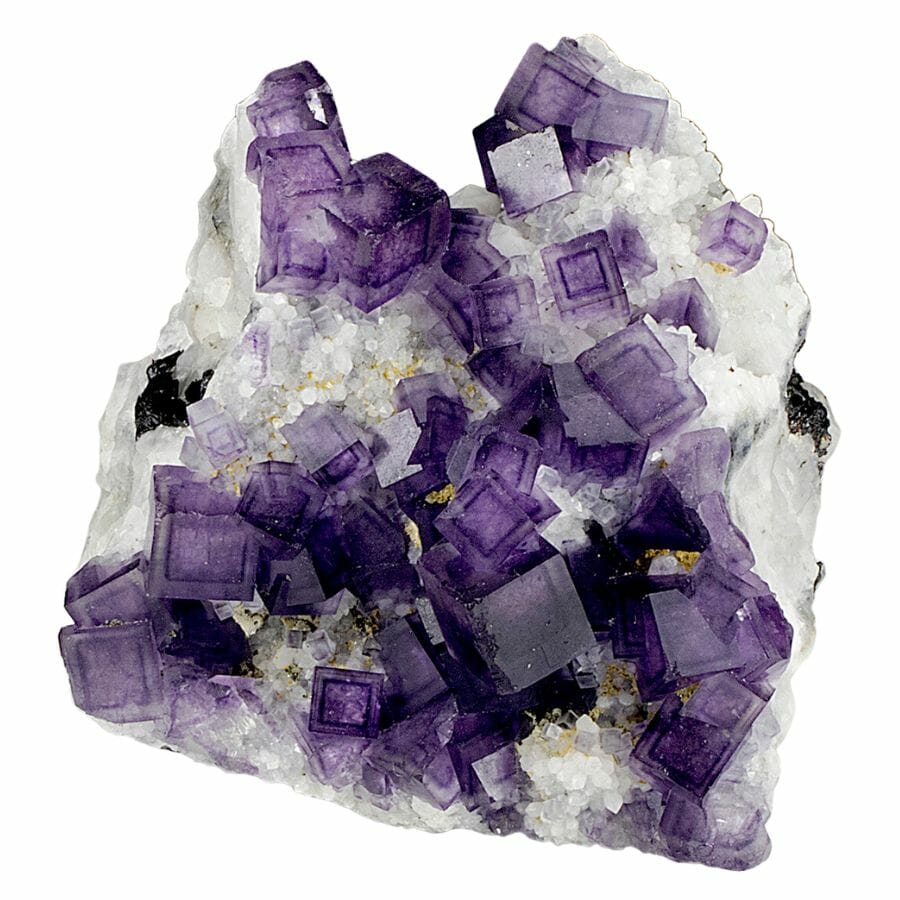
Alright, rock enthusiasts, let’s shine a light on the colorful world of fluorite! If you ever wished for a rainbow trapped in a stone, fluorite might just be that dream come true, especially in the rocky playground of Arizona.
Fluorite comes in a bunch of awesome colors. It can be purple, green, yellow, blue, or even clear! Sometimes, it mixes a few colors in one stone, making it look like a magical crystal.
So how does this colorful wonder come to be? Fluorite forms when hot water full of minerals flows through cracks in rocks. As the water cools down, the minerals start to stick together and form crystals.
Over a long time, these crystals grow bigger and become the fluorite we know and love.
Here’s a fun fact: fluorite can glow under ultraviolet light. Scientists value it for its role in scientific research, and collectors adore it for its unique and vibrant colors.
Where you can find fluorite in Arizona
- Old Spanish Mine, Pima County
- Pool’s Mine, Lee Mountain area, Saddle Mountain Mining District
- Black Pearl Mine, Loco Creek, Eureka Mining District
Pyrite
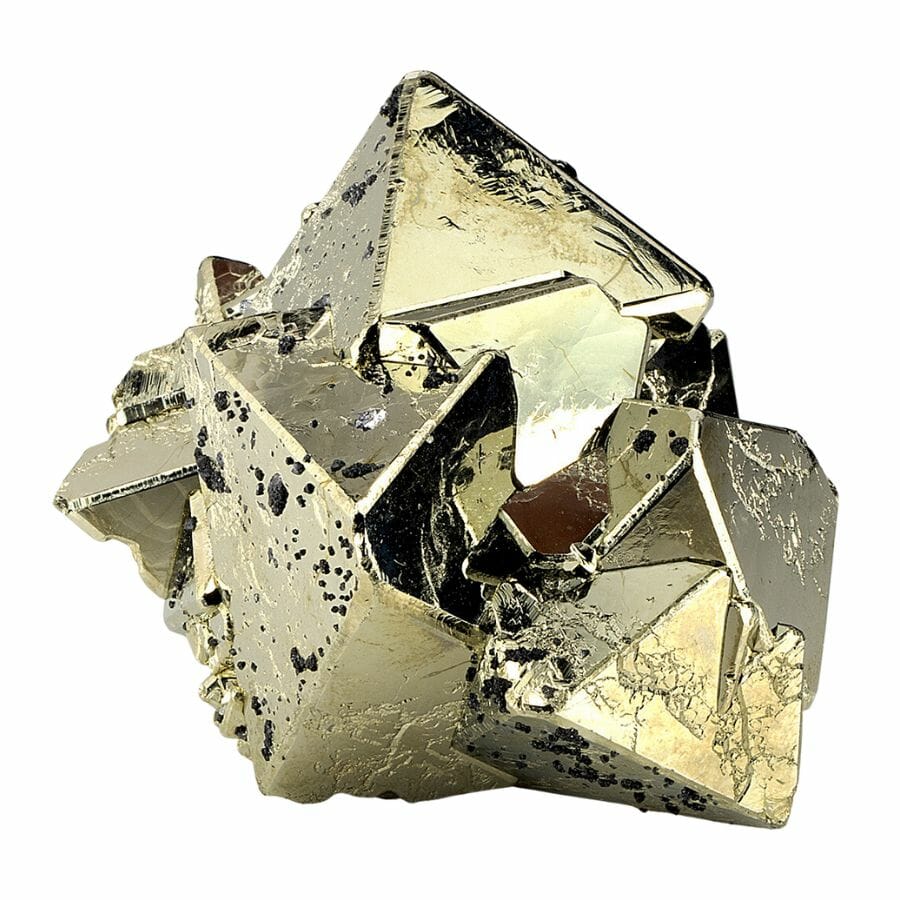
Pyrite is often called “fool’s gold” because of how similar it looks to the precious metal. It might trick you with its shiny, gold-like appearance, but it’s a unique and awesome mineral all on its own.
This mineral forms when iron and sulfur bond together under certain conditions. It can grow in all sorts of places like sedimentary rocks, volcanic rocks, and even in coal beds.
Arizona, with its diverse geology and plenty of underground magic, provides some excellent spots where pyrite can form. That’s why the variety of crystals found in Arizona attracts both seasoned geologists and curious explorers alike.
Aside from its cool, golden shimmer, pyrite has some other neat uses. Long ago, people used it to create sparks, kind of like an ancient lighter.
Also, because of its metallic look, it’s a hit among mineral collectors and is often used in jewelry and decorations.
Where you can find pyrite in Arizona
- Jack White Mine, Winifred Mining District, Phoenix Mountains
- Black Mesa, Mohave County
- Black Pearl Mine, Loco Creek, Eureka Mining District
Quartz
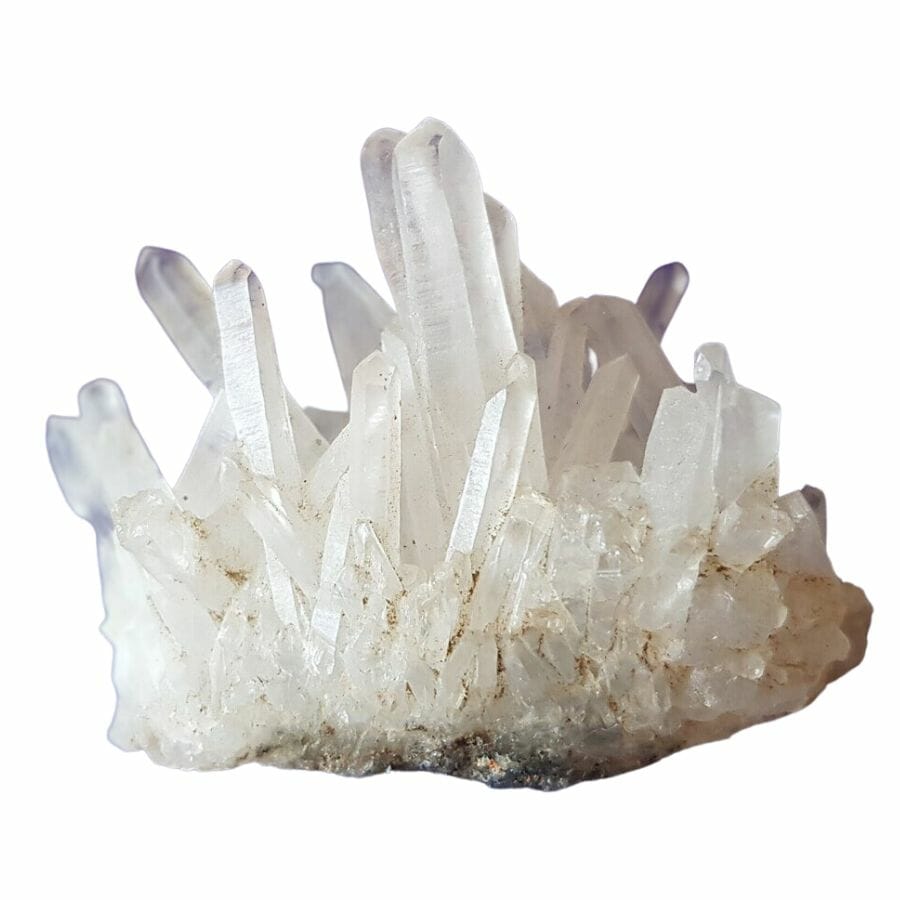
Quartz is clear and sparkly, but it can also come in a rainbow of colors, from pretty purples to rosy pinks and even smoky browns.
It loves to grow in cracks and spaces inside rocks. When hot water filled with dissolved minerals moves through these spaces and then cools down, quartz starts to crystallize.
Think of it like sugar crystallizing in a supersaturated solution to make rock candy.
Arizona has a lot of varied landscapes and a lot of geothermal activity, which is why you’ll find quite a bit of quartz here.
Quartz is super versatile. You can find it in everyday items like watches, and it even helps power electronics.
People have also been using quartz for jewelry for ages. Its sparkle and variety of colors make it a big hit. Plus, many believe that different types of quartz have special energies or healing properties.
Where you can find quartz in Arizona
- Castle Hot Springs
- Coolidge Dam
- Agua Fria River (stream), Bradshaw Mountains
Dioptase
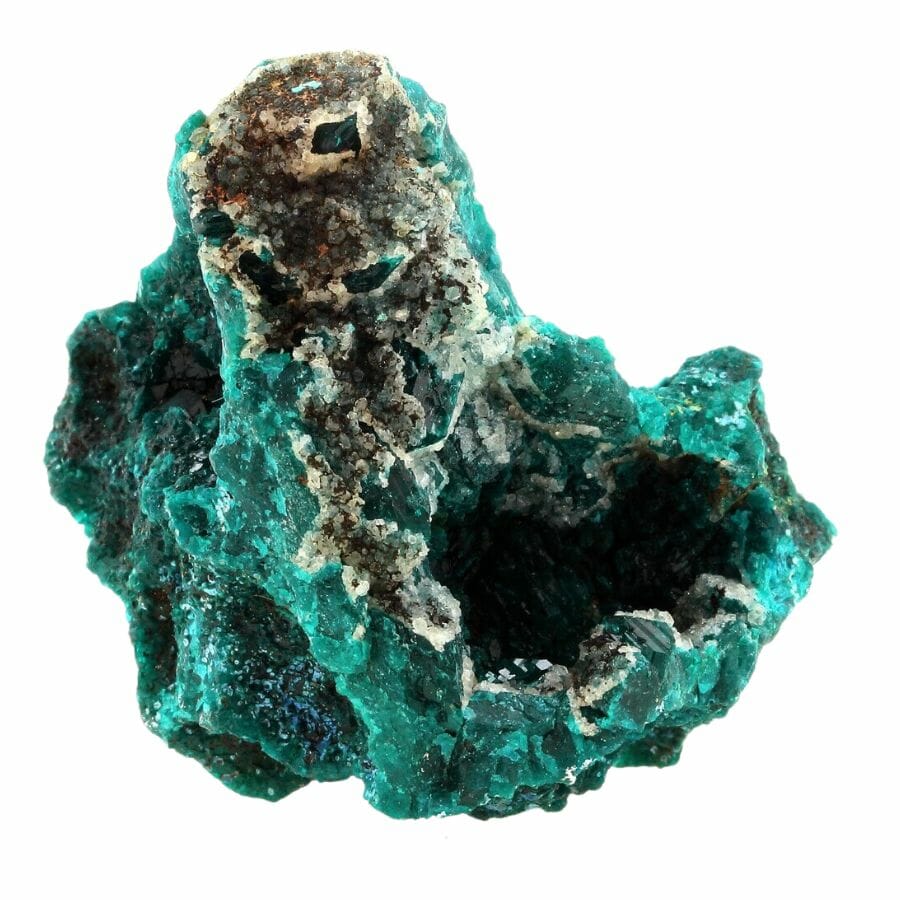
Dioptase, with its vibrant green sparkle, is one of the most eye-catching crystals found in Arizona. Imagine a gem with the vibrant green of a rainforest, and you’ve got dioptase!
This mineral is born when copper-rich water reacts with silica and certain conditions deep in the Earth. This special mix, under the right temperature and pressure, creates those stunning green crystals.
Arizona, with all its awesome geothermal activities and copper deposits, is just the right kind of place for dioptase to grow.
Dioptase’s brilliant color is a total crowd-pleaser. Mineral collectors go bananas for it. Plus, while dioptase looks like an emerald, it’s actually way rarer, which makes it super special.
People also value it for its healing properties. Some believe that this gem can bring peace, balance, and emotional healing.
Where you can find dioptase in Arizona
- Bonanza Mine, Bonanza and Golden Eagle Mine group, Martin Peak, Salome
- Johnson Camp, Gunnison Copper Project, Cochise Mining District
- Eagle Eye Mine, Moore Mine group, New Water Mining District, New Water Mountains
Selenite
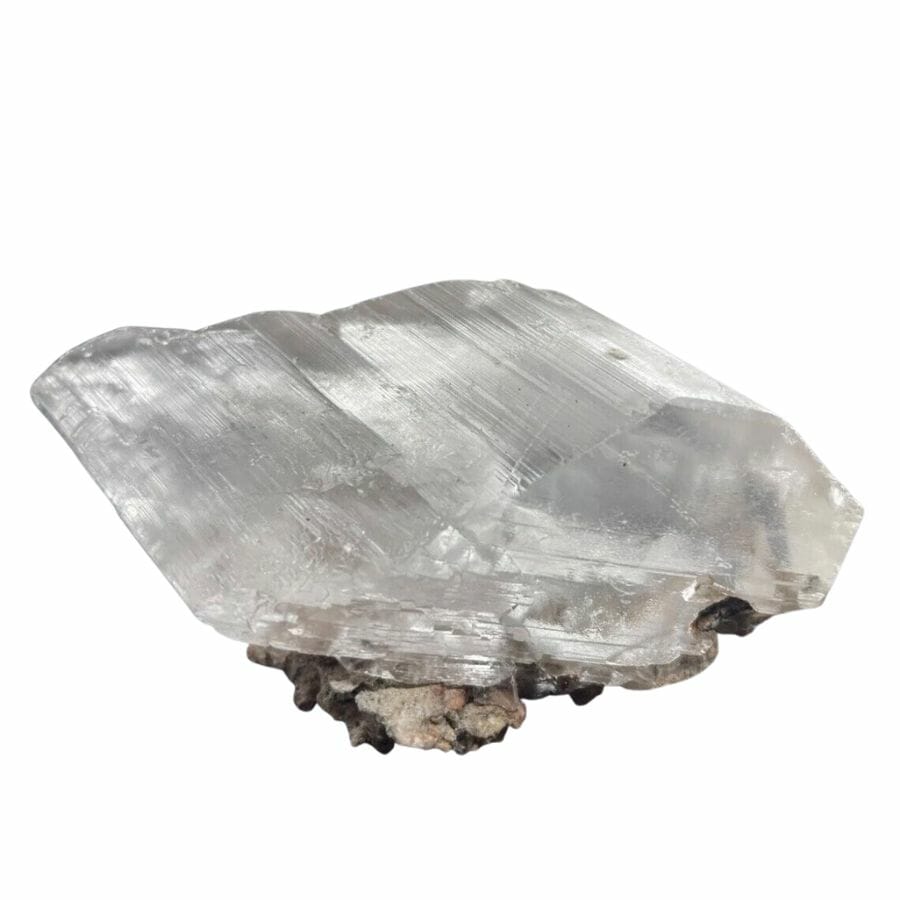
Picture a crystal that’s so clear and sparkly, it looks like frozen moonlight. That’s selenite for you!
Selenite is a type of gypsum, and it loves to form in watery spots, like salt flats or areas that once had ancient lakes. When water evaporates from these places, selenite starts to crystallize.
Arizona, with its deserts, once-upon-a-time lakes, and unique below-the-ground conditions, is a dream home for selenite to grow.
Those clear, shiny crystals can grow super big, making them a hit among people who love collecting minerals. Plus, it’s sometimes used in decoration because of its lovely glow.
Selenite is also popular for its peaceful energy. Many believe that it can clear negative vibes and bring calm to a space.
Where you can find selenite in Arizona
- Toltec Divide Area Gypsum deposit, Winslow, Winslow Mining District
- Lucky 44 claim, Mohave County
- Monument No. 2 Mine, Monument No. 2 channel, Yazzie Mesa, Cane Valley Mining District
Our Favorite Places For Gem Mining In Arizona
The beautiful gems of our state are not confined to one location, so we prepared a list of our favorite places where adults and children can experience the thrill of gem mining. For adults, these locations prove to be the best venues for real gem hunting. For kids, we selected places where they can be encouraged to start and continue their gem mining journey at an early age.
Always Confirm Access and Collection Rules!
Before heading out to any of the locations on our list you need to confirm access requirements and collection rules for both public and private locations directly with the location. We haven’t personally verified every location and the access requirements and collection rules often change without notice.
Many of the locations we mention will not allow collecting but are still great places for those who love to find beautiful rocks and minerals in the wild without keeping them. We also can’t guarantee you will find anything in these locations since they are constantly changing.
Always get updated information directly from the source ahead of time to ensure responsible rockhounding. If you want even more current options it’s always a good idea to contact local rock and mineral clubs and groups
Round Mountain Rockhound Area
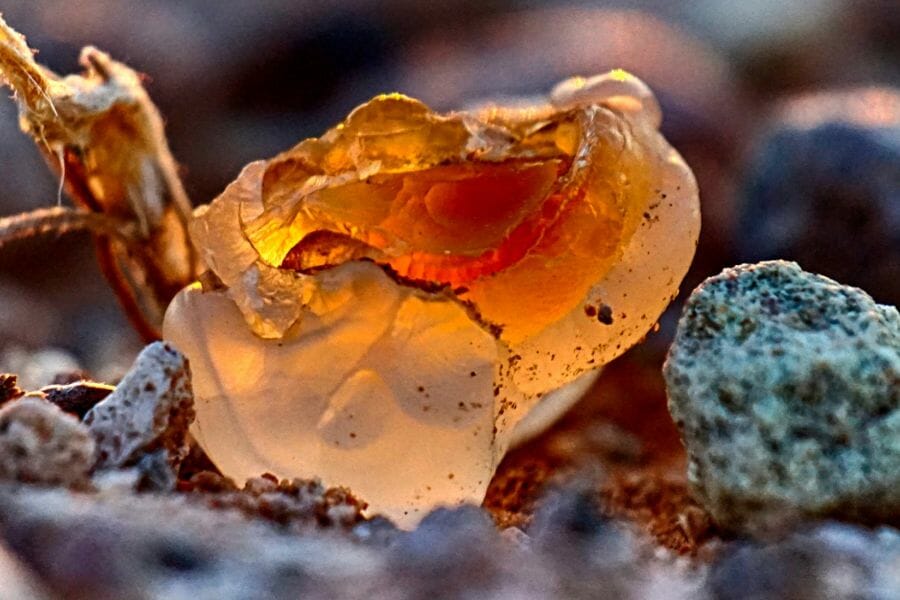
711 14th Avenue, Safford, AZ 85546
Located in the western part of our state near Yuma, Round Mountain Rockhounding Area is known for its abundance of different kinds of gems. The area has a rich history that dates back to the 1800s when prospectors first discovered gold in the area.
Today, it remains to be a great place to discover the state’s most precious gems. You are allowed to collect up to 25 pounds of rocks and minerals per day, as long as they follow the rules and regulations of the area.
Be cautious when driving or walking around while visiting since some areas may be off-limits due to environmental concerns.
The Types of Gems Found In The Round Mountain Rockhound Area
This location is among the top of mind places for people wanting to search for gems. It is known for having an abundance of the following:
- Fire Agate
- Chalcedony
- Jasper
- Turquoise
The Best Time To Visit Round Mountain Rockhound Area
If you wish to visit, the best time to do so is during the cooler months of October through April, when the weather is generally cooler and more conducive to outdoor activities.
Additionally, the area is not as crowded as it can be during the peak tourism months, making it easier to access the area and enjoy your experience without interruption.
If you want REAL results finding incredible rocks and minerals you need one of these 👇👇👇
Finding the coolest rocks in isn’t luck, it's knowing what to look for. Thousands of your fellow rock hunters are already carrying Rock Chasing field guides. Maybe it's time you joined the community.
Lightweight, mud-proof, and packed with clear photos, it’s become the go-to tool for anyone interested discovering what’s hidden under our red dirt and what they've already found.
Join them, and make your next rockhounding trip actually pay off.
What makes it different:
- 📍 Find and identify 140 incredible crystals, rocks, gemstones, minerals, and geodes across the USA
- 🚙 Field-tested across America's rivers, ranchlands, mountains, and roadcuts
- 📘 Heavy duty laminated pages resist dust, sweat, and water
- 🧠 Zero fluff — just clear visuals and straight-to-the-point info
- ⭐ Rated 4.8★ by real collectors who actually use it in the field
Peridot Mesa Mine
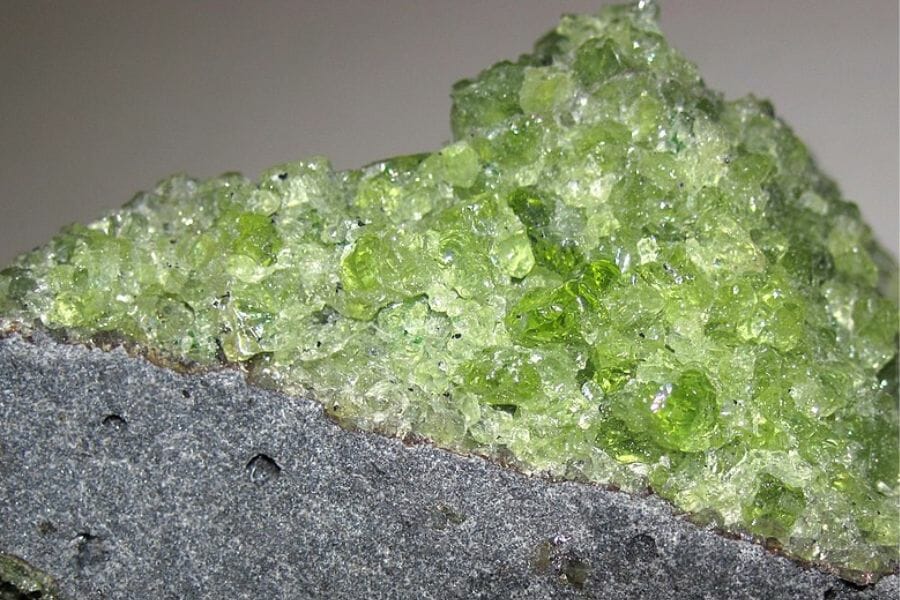
San Carlos Reservation, AZ 85550
Peridot Mesa Mine is a large gem mining site located in the San Carlos Apache Indian Reservation. It was initially discovered by miners from the nearby Globe area who were looking for gold and silver.
However, they soon realized that the site was rich in peridot and began to produce it commercially.
The mine has been in operation since the early 1900s and is still producing today. It’s one of the few places where peridot can be found naturally occurring, making it an invaluable resource for gemstone collectors and enthusiasts alike. Aside from this, Peridot Mesa Mine is also one of the best places to find Arizona crystals.
The Types of Gems Found In The Peridot Mesa Mine
This place is known for its high-grade peridot gems, which are found in abundance at the mine.
The Best Time To Visit Peridot Mesa Mine
The best time to visit this location is in the late fall through early spring, from October through April. The weather is mild and the days are long, allowing for plenty of time to explore the mine and search for gems. While the days are usually sunny and warm, it can get quite hot during the afternoon hours so make sure to come prepared.
Meadow Creek Pass
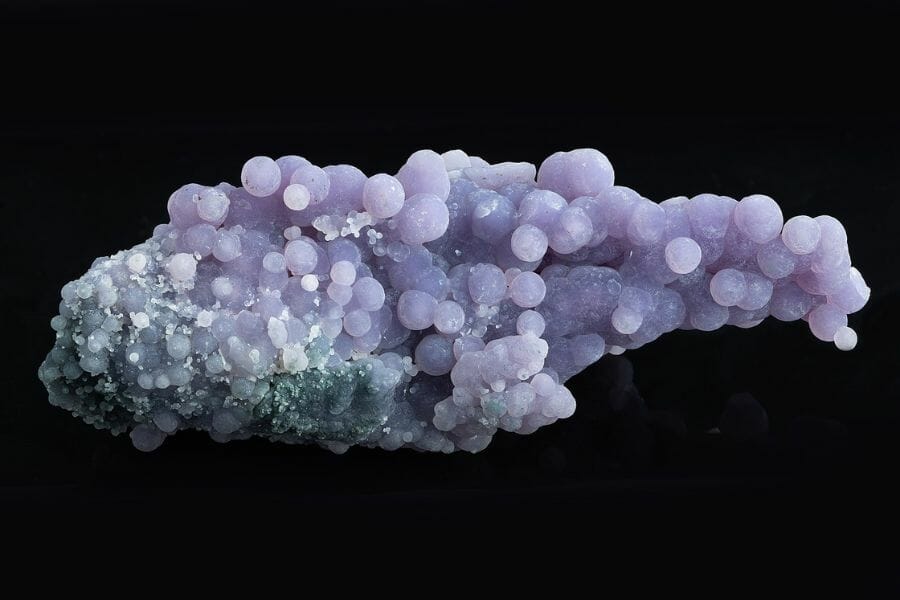
Mohave County, AZ 86413
Meadow Creek Pass is a popular gem mining area located in the White Mountains of the state. The history of Meadow Creek Pass dates back to the 1800s, when prospectors first began exploring the area in search of valuable gems and minerals.
Since then, many have made their way to this place in hopes of striking it rich. The area has been popular with rockhounds and miners, becoming known to produce some of the finest gemstones found throughout the state.
The Types of Gems Found In The Meadow Creek Pass
This location has plenty of different kinds of gemstones, but the most abundant of these are the following:
- Chalcedony
- Fire Agate
- Grape Agate
- Jasper
The Best Time To Visit Meadow Creek Pass
If you are planning to visit, the best time to be at this place is from October to March or April. The weather during this period is usually mild and dry, making it an ideal time for outdoor activities such as gem mining. Also, be sure to check the weather forecast before visiting.
Four Peaks Mining Co. – Great for kids
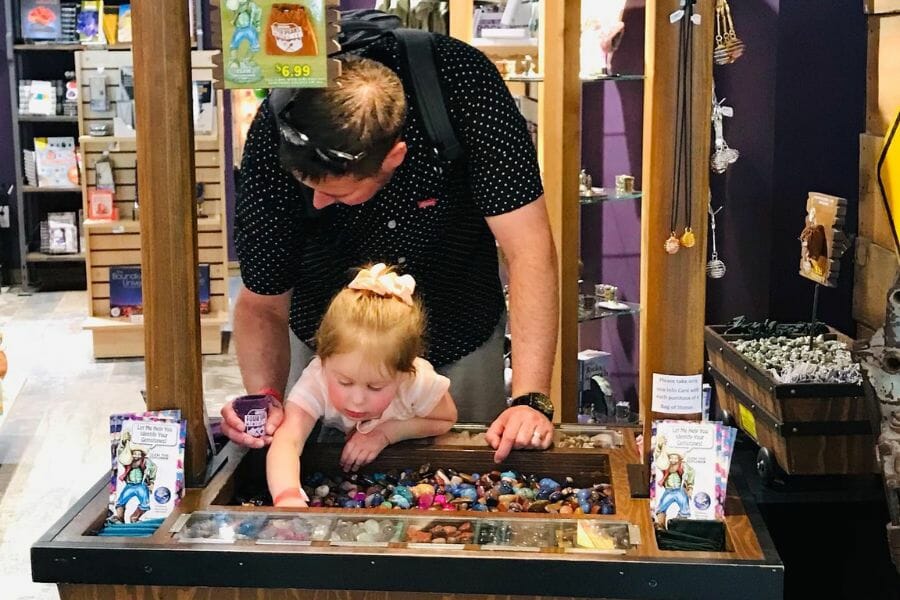
9500 East Vía de Ventura Suite D-110, Scottsdale, AZ 85256
Four Peaks Mining Co. specializes in providing an educational experience to you through interactive gem mining adventures. Kids can try their hand at digging for gems here. The company also sells a wide selection of gemstones, including necklaces and jewelry crafted from the ones they find during their adventures.
The Types of Gems Found In The Four Peaks Mining Co.
This place is great for kids to be introduced to different kinds of gems, but this area is most well-known for having the following:
- Amethyst
- Hematite
- Quartz
The Best Time To Visit Four Peaks Mining Co.
The best time to visit is during the cooler months of October to May when temperatures are mild and the weather is generally sunny. This is when you will be able to find the most gems and have the best experience.
Gold King Mine Ghost Town – Great for kids
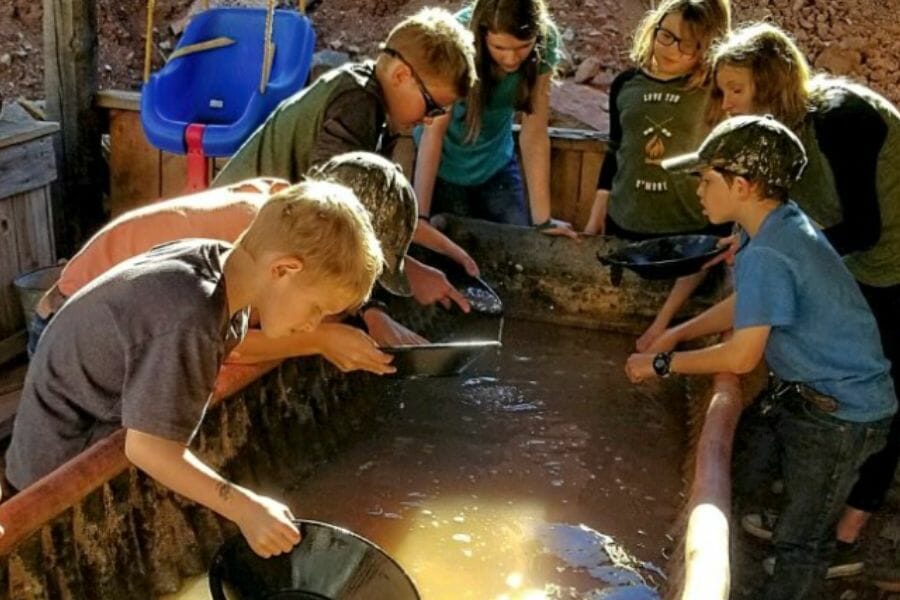
1000 Perkinsville Rd, Jerome AZ 86331
Gold King Mine Ghost Town is an abandoned mining town that dates back to the late 1800s, when it was one of the most productive mines in the area. The town was home to a bustling mining industry, which produced gold and copper until it was abandoned in 1953, when the mine shut down due to a lack of ore.
Today, Gold King Mine Ghost Town is a popular tourist destination for those who are interested in exploring the history of mining in the region.
You can take guided tours through the ruins of old buildings, pan for gems and minerals at nearby gem mining sites, and learn about the history of gold and copper production in Jerome. You can also take part in educational programs designed to teach you about our state’s rich mining history.
The Types of Gems Found In The Gold King Mine Ghost Town
As the name of the place implies, this area is most abundant in gold that you can pan for experience.
The Best Time To Visit Gold King Mine Ghost Town
The best time to visit is late fall through early spring. The weather is usually mild during this time and the area has a lot of daylight hours. Avoid visiting during the summer months, when temperatures can reach over 100°F (37°C) in this area, and make sure to plan accordingly.
Other Great Options For Real Gem Mining in Arizona
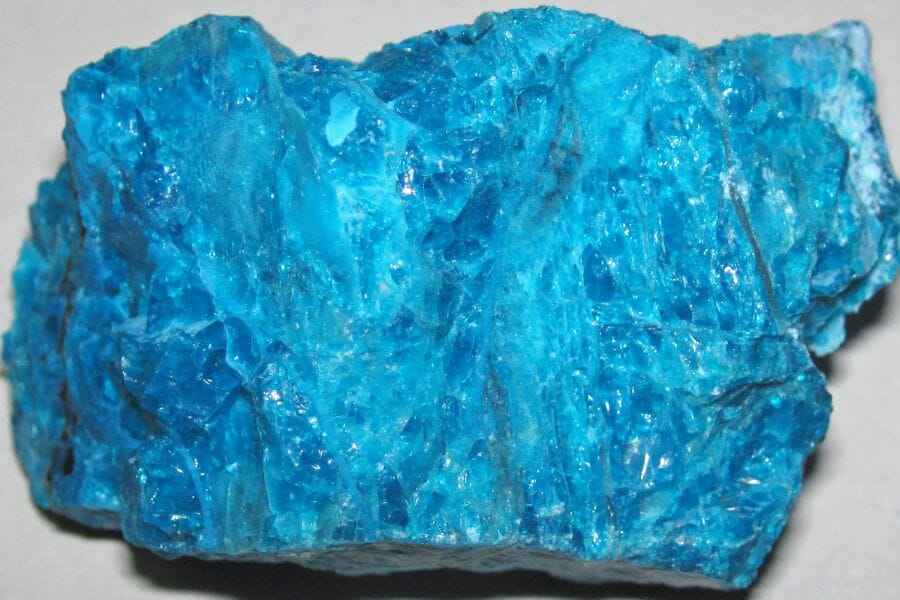
As a gem hunter’s paradise, our state is rich in different places for this activity. Aside from our favorite areas, we also made a list of the other great locations that adults will have a blast exploring.
- Cave Creek – Agate, Jasper, Magnetite, Quartz
- Ajo – Agate, Chalcedony, Jasper
- Bisbee – Aragonite, Azurite, Bornite, Calcite, Chrysocolla, Cuprite, Malachite, Shattuckite
- Bouse – Agate, Quartz
- Skunk Creek – Pink Chalcedony
- Peloncillo Mountain – Fire Agate
- Castle Hot Springs – Agate, Chalcedony, Feldspar, Garnet, Jasper, Quartz, Tourmaline
- Bullhead City – Agate, Chalcedony, Jasper
- Coolidge Dam – Agate, Andradite
- Black Mountain – Chalcedony, Fire Agate
- Agua Fria River – Agate, Chalcedony, Jasper, Quartz
- Plomosa Road – Epidote, Quartz
- Burro Creek – Pink Agate
- Copper Queen and King Mine – Azurite, Chrysocolla, Pyrrhotite
- Neptune Mine – Fluorite
- Go John Mine – Blue Quartz, Red Jasper
- Meadow Creek Pass – Chalcedony, Fire Agate, Grape Agate, Jasper
- Emerald Isle Mine – Chrysocolla
The Top Public Gem Mining Locations in Arizona
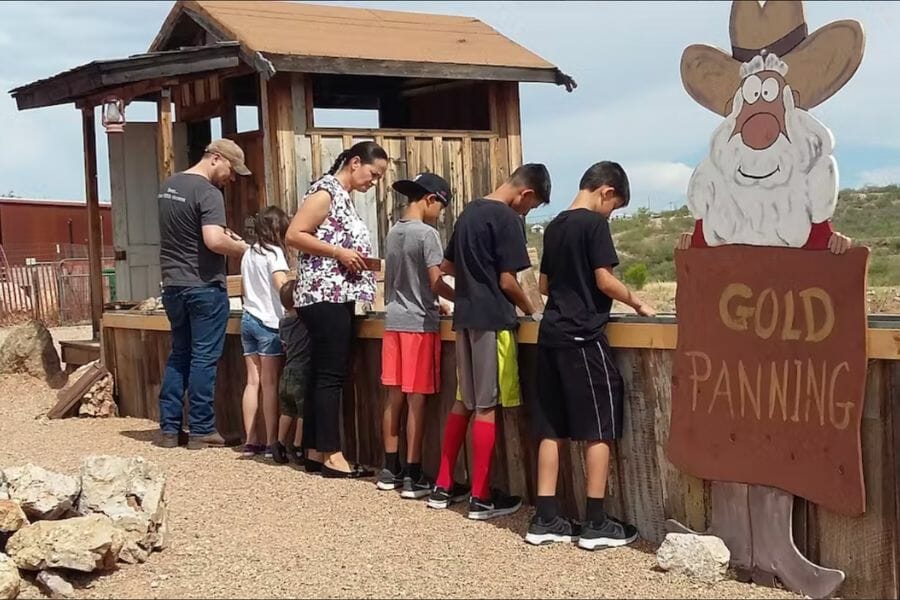
If you are looking for family-friendly locations, where kids can enjoy the experience of gem mining be it their first time or not, below are our best suggestions.
- Queen Mine Tour – 478 N Dart Rd Bisbee, AZ 85603
- The Hull Mine – Castle Dome Museum, Castle Dome Road, Yuma AZ
- Cave Creek Museum – 6140 E Skyline Drive, Cave Creek, AZ 85331
- Goldfield Ghost Town – 4650 N. Mammoth Mine Rd. Apache Junction, AZ 85119
- Goodenough Silver Mine – 501 E Toughnut St, Tombstone, AZ 85638, United States
Arizona Gem Mining Laws And Regulations
To ensure the safety and enjoyment of recreational gem miners, our state has put in place the Arizona Department of Mines and Mineral Resources (ADMMR) Regulation 8-2012, which is the main regulation governing recreational gem mining.
Under ADMMR Regulation 8-2012, gem miners must obtain a permit from the ADMMR prior to engaging in any activities. In addition, you must have appropriate safety equipment such as hard hats, eye protection, and gloves. You must also follow all applicable laws regarding water rights, land use, and environmental protection when conducting their activities. Finally, all gems recovered during any mining activities must be reported to the ADMMR within 30 days of recovery.
For more information on the state’s gem mining laws and regulations, visit the Arizona Department of Mines and Mineral Resources’ link above.
Additional places to mine for gems in nearby states
Check out the guides we made for the places we think you should visit once you’ve explored each of the places we listed above to find gems in neighboring states:
- Gem mining in California
- Gem mining in Colorado
- Gem mining in Nevada
- Gem mining in New Mexico
- Gem mining in Utah
If you have any recommendations we haven’t covered, please leave them in the comments below!

